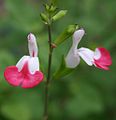Salvia microphylla
| Salvia microphylla subsp. var. | Little-leafed sage | |||||||||||||||||||||||||||||||||||||||||||||||||||||||
|---|---|---|---|---|---|---|---|---|---|---|---|---|---|---|---|---|---|---|---|---|---|---|---|---|---|---|---|---|---|---|---|---|---|---|---|---|---|---|---|---|---|---|---|---|---|---|---|---|---|---|---|---|---|---|---|---|

|
|
| ||||||||||||||||||||||||||||||||||||||||||||||||||||||
| ||||||||||||||||||||||||||||||||||||||||||||||||||||||||
Salvia microphylla (Baby sage, Graham's sage) is a perennial shrub found in the wild in southeastern Arizona and the mountains of eastern, western, and southern Mexico. It is a very complex species which easily hybridizes, resulting in numerous hybrids and cultivars brought into horticulture since the 1990s. The specific epithet, "microphylla", from the Greek, means "small leaved". In Mexico, it is called "mirto de montes", or "myrtle of the mountains".[1]
Salvia microphylla grows to 1-1.3m tall and wide, blooming in its first year and growing to full size in its second year. The leaves are ovate shaped, of varying sizes, and smooth or lightly covered with hairs. The leaves have a pleasant mint-like fragrance when crushed. It typically flowers in its first year, and reaches full size in the second year. It sometimes spreads underground, producing dense patches.[1]
Along with its cultivars and hybrids, S. microphylla blooms heavily in late spring and again in autumn, with sporadic flowering year-round in mild conditions. The flowers are arranged in whorls, with a wide range of color: magenta, red, pink, and rose.[1]
| Standard Cyclopedia of Horticulture |
|---|
|
Salvia grahamii, Benth. Shrub, 2-3 ft. high: st. shrubby with glabrous or very slightly pubescent branches: lvs. petiolate, oval, obtuse, base rounded or cuneate, irregularly crenate in the center, subglabrous; floral lvs. ovate, acuminate, ciliate, deciduous: racemes elongated, more than 1 ft. long; floral whorls 2-fld.; calyx tubular, striate-nerved, pubescent, frequently colored; corolla deep crimson or when older purple, the midlobe of the lower lip, which is large and obcordate, has two small white spots. Summer. Mex. CH
|
Cultivation
Propagation
Pests and diseases
Varieties
Cultivars and hybrids:
- 'Cerro Potosi'—large vibrant magenta flowers
- 'Hoja Grande'—magenta-red flowers and dark green leaves
- 'La Trinidad Pink'—bright pink flowers
- 'Rosita'—repeat bloomer with bright candy-pink flowers
- 'San Carlos Festival—magenta-scarlet flowers and gray-green leaves
- 'Desert Blaze'—bright red flowers and variegated yellow and green leaves
- 'Forever Red'—shrublike, long-blooming, scarlet flowers
- 'Graham's Sage'—many red flowers blooming simultaneously
- 'Kew's Red'—vigorous grower with vivid red flowers
- 'La Foux'—deep crimson flowers with dark calyces
- 'Newby Hall'—robust plant, bright scarlet flowers
- 'Pink Blush'—free flowering, rose-magenta flowers
- 'Red Velvet'—lustrous red flowers
- 'Wild Watermelon'—large pink flowers with dark calyces[1]
- 'Kirsch Pink'-pink flowers, developed by Toyota[2][3]
Gallery
References
- ↑ 1.0 1.1 1.2 1.3 Clebsch, Betsy; Carol D. Barner (2003). The New Book of Salvias. Timber Press. pp. 192–193. ISBN 9780881925609.
- ↑ Berg, Ivan; Nik Berg (2006). Top Gear Motor Mania. London: BBC Books. pp. 76. ISBN 0-563-49362-3.
- ↑ TOYOTA DEVELOPS ECO-FRIENDLY SHRUB. Web Japan. November 28, 2005. Accessed online: 18 April 2009.
External links
- w:Salvia microphylla. Some of the material on this page may be from Wikipedia, under the Creative Commons license.
- Salvia microphylla QR Code (Size 50, 100, 200, 500)

